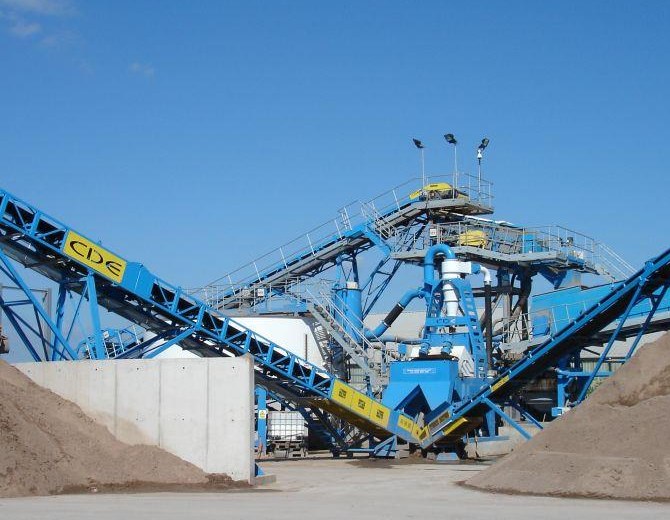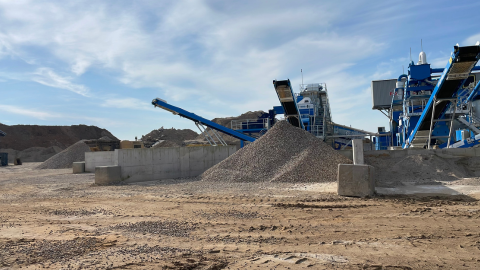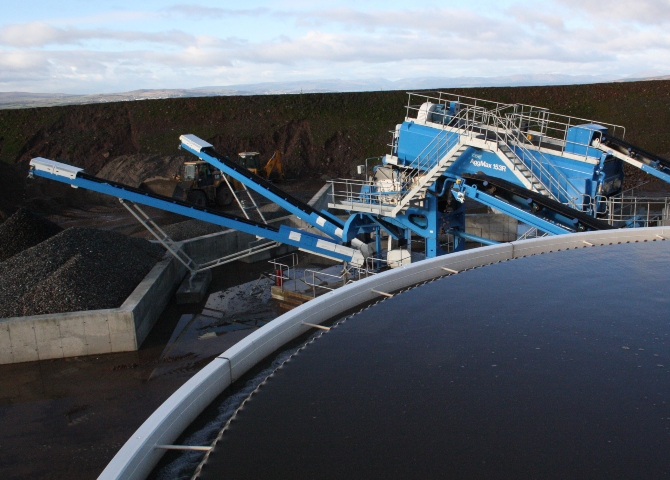Tonnage
80tph
Material
Sand & Gravel
Output
0-2mm building sand | 0-4mm concrete sand | 4-10mm, 10-20mm and 20-40mm washed aggregates | +40mm oversize aggregate

THE PROBLEM
The site is operated by Raymond Brown who currently have eleven locations across Hampshire, Dorset, Wiltshire, Oxfordshire and Berkshire. Roke Manor quarry is the latest addition to the group portfolio having been officially opened by Group Chairman, Ron Isaac in November 2014.
“The new site was seven years in development and planning permission was granted in 2011” explains Richard Hoare, Project Manager at Raymond Brown. “Our licence will see us extract 750,000 tonnes of sand and gravel at a rate of 125,000 tonnes per year.”
The permission is accompanied by a 30-year woodland management plan which involves additional tree planting in line with an approved landscaping plan that formed part of the planning permission. The site is located 11 miles from Southampton on the outskirts of the New Forest and it was the sensitivity and environmental responsibility displayed by Raymond Brown which resulted in the successful planning application.

THE SOLUTION
The new washing plant at Roke Manor will process sand and gravel at a rate of 80 tonnes per hour and includes several items of equipment from the CDE portfolio including the AggMax modular logwasher EvoWash sand washing plant, AquaCycle thickener and decanter centrifuge as well as a feed hopper and transfer and stockpile conveyors.
Material is delivered to the plant via the M14 feed hopper with 150mm grid spacings. CDE conducted extensive material testing prior to specifying the plant and the vast majority of material being processed is in the minus 63mm range with 80% typically passing 20mm. “Raymond Brown were looking for performance guarantees that gave them confidence in the capability of the plant to tackle high fines and clay content in the feed material and produce a range of washed sand and aggregate products that would meet their customers’ requirements” explains Chris McKeown, Technical Manager at CDE. “Our performance statement covers the production of a range of products from the new plant to agreed specifications: 0-4mm concrete sand, 0-2mm building sand, 4-10mm, 10-20mm and 20-40mm aggregates and a +40mm oversize.”
This agreement was reached after extensive material testing at Roke Manor to establish parameters around the likely variations in feed material within the deposit. “It is only through the extensive material testing that we conduct on every project that we are able to deliver washing plants which deliver on our customers’ requirements through the production of consistently graded washed sand and aggregates” explains Matt Bunting, Director of Business Development in the UK for CDE. “This allows us to work with customers on the kind of performance statements included on this project for Raymond Brown.”
The feed material is transferred to the first stage of processing via a 23 metre conveyor with an 800mm belt. At the head of this conveyor a washbox fluidises the material before delivery to the AggMax modular logwasher.
Before material enters the AggMax a double deck horizontal screen is employed as a pre-screen to remove the +40mm oversize material and the -4mm sand from the feed material. The +40mm oversize is stockpiled in a bay underneath the AggMax via an integrated 4m horizontal conveyor with a 650mm belt. The feed material contains an average of 9 tonnes per hour of this oversize material.
While the top deck of the screen removes the oversize material the -4mm material falls through the bottom deck of the screen and is sent to the sand washing phase. This is an important step in protecting the plant explains Matt Bunting. “Logwashers and sand are not a very good combination as if the sand is allowed to get into the logwasher it will result in excess wear on the machine. By removing the sand fraction at this stage we are able to protect the machine, ensuring maximum plant availability and allowing Raymond Brown to maximise their production volumes and the return on their investment.”
Material from the bottom deck of the prescreen is delivered to the AggMax modular logwasher at a rate of 47 tonnes per hour on average where the material is subjected to high levels of attrition before being discharged to a triple deck sizing screen which is integrated onto the AggMax chassis.
The AggMax is one of the most popular products that CDE offer and is specified on a range of projects from sand & gravel and crushed rock processing to C&D waste recycling and iron ore processing. “The design of the AggMax has been refined over the last 10 years to ensure it continues to offer our customers the highest level of scrubbing performance while also including a range of design features which ensure it is operational for as close to 100% of the time as possible” explains Product Development Manager at CDE, Glenn Sloan.
The most obvious design feature of the AggMax is the arrangement of the paddles in a fan configuration which not only maximises the material on material impact within the machine but reduces shock loads on the bearings to deliver extended equipment life and a reduced power requirement.
The AggMax also features enhanced bearing protection with the main bearing housings located on the outside of the machine. “The AggMax bearing arrangement features 13 levels of bearing protection to eliminate the potential for material and water ingress – protecting the machine and ensuring our customers are able to concentrate on meeting their production targets” explains Glenn Sloan. There is also a bearing temperature sensor which has the capability to automatically shut down the plant if the temperature goes beyond a defined level, maximising equipment life and minimising the time required for essential plant maintenance. The scrubbed aggregates are discharged onto an integrated triple deck sizing screen to produce the 4-10mm, 10-20mm and 20-40mm aggregate products. These are then stockpiled via three 15m stockpile conveyors with 650mm belts.

THE RESULTS
The EvoWash range offers the customer the opportunity to define the cut points for the sand to be produced. “Our EvoWash sand plants, in their various forms are proven to deliver customers the best possible results from their washing operations” explains David Kinloch, UK Business Development Director for CDE. “We can guarantee that only your -63 micron material is sent to the ponds, thus maximising the quantity of sand produced by the washing operation.” In addition to this, the dewatering capability of the EvoWash fine sands wash plantis industry leading. “We can offer our customers dewatered sand with a moisture content of around 12%” adds Kinloch. “In fact, in a large number of cases we have delivered sand with a moisture content of less than 10%.” The key to these results is the fact that each of the CDE EvoWash plants is customised to the specific output requirements and material characteristics of the individual customer.
“We understand that in no two operations, is the feed material likely to have exactly the same characteristics” explains David Kinloch. “Therefore, it does not make sense to offer an off-the-shelf product that makes no attempt to address the individual characteristics of both the feed material, and the customers output requirements.”




